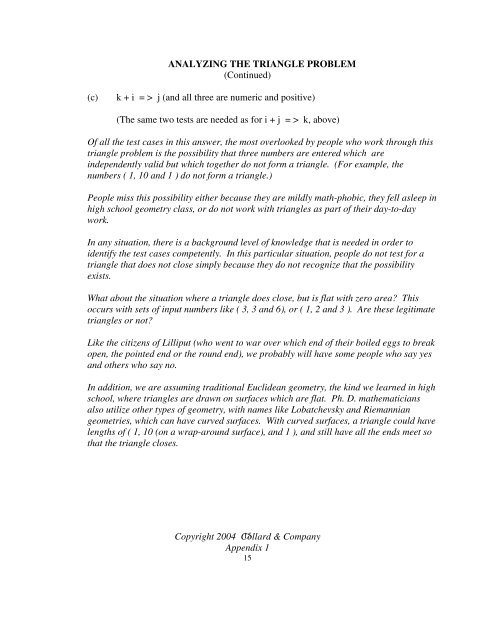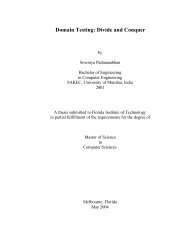appendix 1. analyzing the triangle problem - Testing Education
appendix 1. analyzing the triangle problem - Testing Education
appendix 1. analyzing the triangle problem - Testing Education
Create successful ePaper yourself
Turn your PDF publications into a flip-book with our unique Google optimized e-Paper software.
ANALYZING THE TRIANGLE PROBLEM<br />
(Continued)<br />
(c) k + i = > j (and all three are numeric and positive)<br />
(The same two tests are needed as for i + j = > k, above)<br />
Of all <strong>the</strong> test cases in this answer, <strong>the</strong> most overlooked by people who work through this<br />
<strong>triangle</strong> <strong>problem</strong> is <strong>the</strong> possibility that three numbers are entered which are<br />
independently valid but which toge<strong>the</strong>r do not form a <strong>triangle</strong>. (For example, <strong>the</strong><br />
numbers ( 1, 10 and 1 ) do not form a <strong>triangle</strong>.)<br />
People miss this possibility ei<strong>the</strong>r because <strong>the</strong>y are mildly math-phobic, <strong>the</strong>y fell asleep in<br />
high school geometry class, or do not work with <strong>triangle</strong>s as part of <strong>the</strong>ir day-to-day<br />
work.<br />
In any situation, <strong>the</strong>re is a background level of knowledge that is needed in order to<br />
identify <strong>the</strong> test cases competently. In this particular situation, people do not test for a<br />
<strong>triangle</strong> that does not close simply because <strong>the</strong>y do not recognize that <strong>the</strong> possibility<br />
exists.<br />
What about <strong>the</strong> situation where a <strong>triangle</strong> does close, but is flat with zero area? This<br />
occurs with sets of input numbers like ( 3, 3 and 6), or ( 1, 2 and 3 ). Are <strong>the</strong>se legitimate<br />
<strong>triangle</strong>s or not?<br />
Like <strong>the</strong> citizens of Lilliput (who went to war over which end of <strong>the</strong>ir boiled eggs to break<br />
open, <strong>the</strong> pointed end or <strong>the</strong> round end), we probably will have some people who say yes<br />
and o<strong>the</strong>rs who say no.<br />
In addition, we are assuming traditional Euclidean geometry, <strong>the</strong> kind we learned in high<br />
school, where <strong>triangle</strong>s are drawn on surfaces which are flat. Ph. D. ma<strong>the</strong>maticians<br />
also utilize o<strong>the</strong>r types of geometry, with names like Lobatchevsky and Riemannian<br />
geometries, which can have curved surfaces. With curved surfaces, a <strong>triangle</strong> could have<br />
lengths of ( 1, 10 (on a wrap-around surface), and 1 ), and still have all <strong>the</strong> ends meet so<br />
that <strong>the</strong> <strong>triangle</strong> closes.<br />
Copyright 2004 Collard 15 & Company<br />
Appendix 1<br />
15








